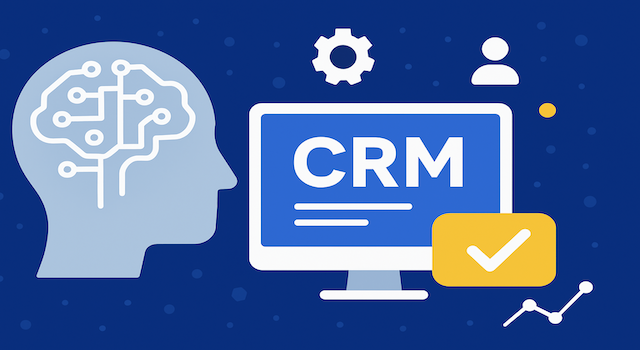Voice Assistants & CRM: Using Conversational AI to Improve Customer Engagement
Introduction: Voice assistants like Siri, Alexa, and Google Assistant have become everyday tools for consumers, but their impact goes far beyond checking the weather or playing music. In the business world, voice-driven technology and conversational AI are transforming how organizations interact with customers and manage relationships. When integrated with Customer Relationship Management (CRM) systems, voice assistants enable more natural interactions, automate repetitive tasks, and empower both sales teams and customers with instant access to information. This article explores the evolving role of voice assistants in CRM, real-world use cases, adoption challenges, and where the technology is headed next.
The Shift from Clicks to Conversation
Traditionally, CRM interactions relied on typing, clicking, and manual data entry. While effective, these methods often slow down workflows and create barriers to adoption. Voice technology offers a more intuitive interface. Sales reps can update CRM records while driving between meetings, support agents can retrieve customer histories hands-free, and customers themselves can engage with companies through conversational bots. This shift from clicks to conversations marks a broader trend toward natural language interfaces in enterprise software.
Key Use Cases of Voice Assistants in CRM
Voice integration isn’t just a novelty—it solves practical business problems. Some of the most impactful applications include:
- Hands-Free Data Entry: Sales representatives on the move can log meeting notes, update contact details, or create follow-up tasks simply by speaking into their phone or headset. The CRM transcribes and saves the data instantly.
- Customer Self-Service: Voice bots integrated with CRM can handle routine inquiries like “What’s the status of my order?” or “When is my appointment scheduled?” reducing the load on human agents.
- Meeting Preparation: Before client calls, voice assistants can summarize account history, open deals, and pending support tickets by pulling data from CRM records.
- Real-Time Coaching: During sales calls, conversational AI can provide prompts or suggestions, alerting reps to upsell opportunities or compliance risks.
- Field Service Support: Technicians can query repair histories, warranty details, or troubleshooting guides without stopping work to use a laptop or tablet.
Benefits of Voice-Enabled CRM
Organizations adopting voice assistants for CRM integration report several advantages:
- Increased Efficiency: Eliminates the bottleneck of manual data entry, allowing teams to focus on higher-value activities.
- Faster Response Times: Customers get immediate answers from voice-enabled bots, reducing wait times.
- Improved Data Quality: Spoken notes entered immediately after meetings are often more accurate and detailed than those logged later.
- Enhanced Accessibility: Voice interfaces make CRM tools easier to use for employees who are not tech-savvy or who work in environments where hands-free operation is necessary.
- Customer Personalization: Conversational AI can recognize customer intent and context, delivering more tailored experiences.
Industry Applications
While any industry can benefit, certain sectors are leading adopters of voice-enabled CRM:
- Healthcare: Doctors and nurses use voice commands to access patient histories from CRM-like EHR systems while keeping their hands free for clinical work.
- Sales Organizations: Mobile sales teams rely on voice assistants for real-time updates, reducing downtime between client visits.
- Retail: Customer service centers use conversational bots to manage inquiries, returns, and loyalty program information seamlessly.
- Hospitality: Hotels allow guests to use smart speakers in rooms to request services, with each request logged in CRM for personalization.
- Logistics and Field Service: Drivers and technicians query schedules, routes, and service records without pausing their tasks.
How Voice Assistants Integrate with CRM
Integration is key for making voice assistants more than a standalone tool. Typical integrations include:
- APIs and Middleware: Voice platforms connect through APIs to push and pull data from CRM systems like Salesforce, HubSpot, or Microsoft Dynamics.
- Natural Language Processing (NLP): AI-driven NLP engines interpret spoken language, map it to CRM fields, and trigger workflows.
- Custom Skills and Actions: Enterprises can build custom Alexa Skills or Google Actions that interface with CRM workflows.
- Voice-to-Text Transcription: Conversations and meeting notes are converted into structured CRM entries automatically.
- AI-Powered Analytics: Insights derived from voice interactions are fed into CRM dashboards for performance tracking.
Challenges and Considerations
Despite the potential, voice integration in CRM comes with challenges:
- Accuracy: Speech recognition struggles with accents, background noise, or industry-specific jargon.
- Data Security: Voice data may contain sensitive customer information, requiring encryption and compliance with regulations like GDPR and HIPAA.
- User Adoption: Employees may resist new technology if it disrupts established workflows or lacks accuracy.
- Integration Costs: Custom development for CRM-voice integrations can be resource-intensive.
- Context Awareness: Voice systems must understand not just words but the business context to provide meaningful outputs.
Privacy and Compliance
Since voice data can include personal or confidential information, compliance is critical:
- Obtain explicit consent before recording or storing conversations.
- Use secure, encrypted storage solutions integrated with CRM systems.
- Apply retention policies that align with broader CRM data governance.
- Ensure vendor contracts specify how voice data is processed and stored.
Failure to address these issues could erode customer trust and expose organizations to legal risk.
Measuring the ROI of Voice-Enabled CRM
Organizations need concrete metrics to justify investments in voice technology. Useful KPIs include:
- Time Saved: Reduction in hours spent on manual CRM updates.
- CRM Data Completeness: Increase in the percentage of accounts with fully updated records.
- Customer Satisfaction Scores: Improvements in CSAT or Net Promoter Scores after implementing voice bots.
- First-Call Resolution: Percentage of inquiries resolved through voice assistants without escalation.
- Adoption Rate: Percentage of staff regularly using voice commands for CRM tasks.
Case Example: Voice Assistants in Sales CRM
Consider a global sales organization where reps spend hours logging calls and meetings. After integrating a voice assistant with their CRM, reps could dictate updates immediately after client meetings. The system automatically tagged contacts, created follow-up tasks, and summarized notes. Within six months, CRM data accuracy improved by 30%, administrative time decreased by 25%, and reps reported higher satisfaction because they could focus more on selling than typing.
Future Outlook: Where Voice and CRM Are Headed
The next generation of voice-enabled CRM will go beyond simple transcription and commands. Key developments include:
- AI-Driven Predictive Suggestions: Voice assistants will proactively suggest next best actions during calls or meetings.
- Multilingual Support: Advanced NLP will allow global organizations to interact in multiple languages seamlessly.
- Contextual Awareness: Voice systems will pull in data from IoT devices, calendars, and external sources to provide richer insights.
- Embedded Voice in CRM Apps: Rather than using third-party devices, CRMs themselves will come with native voice interfaces.
- Cross-Channel Orchestration: Voice interactions will be part of omnichannel CRM strategies, complementing chat, email, and in-person service.
Implementation Roadmap
For organizations looking to adopt voice technology in CRM, a phased approach works best:
- Pilot: Start with simple use cases like note dictation or account lookups.
- Integration: Connect voice platforms to CRM APIs and workflows.
- Training: Teach staff how to use voice tools effectively and set expectations about accuracy.
- Scaling: Expand to customer-facing voice bots once internal adoption stabilizes.
- Optimization: Use analytics to refine commands, improve accuracy, and expand use cases.
Conclusion
Voice assistants and conversational AI are reshaping the CRM landscape. By enabling hands-free data entry, real-time customer support, and more natural interactions, they bridge the gap between people and technology. While challenges around accuracy, privacy, and adoption remain, the potential for improved efficiency, richer customer data, and stronger engagement makes voice a valuable addition to CRM strategies. Organizations that start experimenting with voice integration now will be better positioned to deliver the seamless, intuitive experiences that customers increasingly expect.







